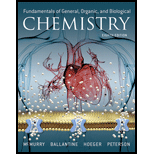
a)
Interpretation: The charge of the cation formed for the given element to be predicted.
Concept Introduction:
Formation of ions:
Atom possesses equal number of protons and electrons and remains electrically neutral. By gaining (accepting electrons) or losing (donating electrons) one or more electrons, convert the neutral atom into a charged particle called IONS.
Cation: The loss of one or more electrons by a neutral atom leaves the atom positively charged called cation.
Anion: The gain of one or more electrons by a neutral atom leaves the neutral atom negatively charged called anion.
b)
Interpretation:
The charge of the cation formed for the given element to be predicted.
Concept Introduction:
Formation of ions:
Atom possesses equal number of protons and electrons and remains electrically neutral. By gaining (accepting electrons) or losing (donating electrons) one or more electrons, convert the neutral atom into a charged particle called IONS.
Cation: The loss of one or more electrons by a neutral atom leaves the atom positively charged called cation.
Anion: The gain of one or more electrons by a neutral atom leaves the neutral atom negatively charged called anion.
c)
Interpretation:
The charge of the cation formed for the given element to be predicted.
Concept Introduction:
Formation of ions:
Atom possesses equal number of protons and electrons and remains electrically neutral. By gaining (accepting electrons) or losing (donating electrons) one or more electrons, convert the neutral atom into a charged particle called IONS.
Cation: The loss of one or more electrons by a neutral atom leaves the atom positively charged called cation.
Anion: The gain of one or more electrons by a neutral atom leaves the neutral atom negatively charged called anion.
d)
Interpretation:
The charge of the cation formed for the given element to be predicted.
Concept Introduction:
Formation of ions:
Atom possesses equal number of protons and electrons and remains electrically neutral. By gaining (accepting electrons) or losing (donating electrons) one or more electrons, convert the neutral atom into a charged particle called IONS.
Cation: The loss of one or more electrons by a neutral atom leaves the atom positively charged called cation.
Anion: The gain of one or more electrons by a neutral atom leaves the neutral atom negatively charged called anion.
Want to see the full answer?
Check out a sample textbook solution
Chapter 3 Solutions
Fundamentals of General, Organic, and Biological Chemistry (8th Edition)
- What is the empirical formula for a compound that is 26.56% potassium, 35.41% chromium, and 38.03% oxygen?arrow_forwardFerrous sulfate is one dietary supplement used to treat iron-deficiency anemia. What are the molecular formula and molecular mass of this compound? howmany milligrams of iron are in 250 mg of ferrous sulfate?arrow_forwardElement Z forms an ion Z 3+, which contains 31 protons. What is the identity of Z, and how many electrons does Z3+have?arrow_forward
- Magnesium atoms lose two electrons when they react. Write the symbol of the ion that is formed. Is it a cation or an anion?arrow_forwardApply the formula for the differences in electronegativities, for the following molecules, and define whether they are polar covalent, nonpolar covalent or ionic. Taking into account that: Non-polar covalent: greater than or equal to 0 but less than 0.7 Polar covalent: greater than or equal to 0.7 but less than 1.7 ionic: greater than 1.7 A)NO B)KCI C)F2 C)AsOarrow_forwardWhich statements are true regarding the chemical formula Pb(NO3)4. Select the three that apply. The formula unit has a ratio of four nitrate ion for every lead (IV) ion. Each Nitrogen atom is bonded with three oxygen atoms Formula unit contains more lead (IV) ions than nitrate ions. Each nitrate ion is bonded with four lead (IV) ions. Each formula unit has total of seventeen atomsarrow_forward
- Ethylene glycol, the main ingredient in antifreeze, contains 38.7% carbon, 9.7% hydrogen and 51.6 % oxygen. Calculate the empirical and molecular formulas for ethylene glycol. Given the molar mass is approximately 60 g/mol. A) Empirical formula: B)Molecular formula: Explain how you obtained the Molecular formula (b)?arrow_forwardWhich of the following compounds would you expect to have the highest boiling pointand which the lowest boiling point? Explain your answer.(a) CH3OCH3 (b) CH3COOH (c) CH3CH2CH3arrow_forward2.3 7 (a) Describe what happens when each of the following molecules is separately dissolved in water and illustrate with an equation in each case: (i) ethanoic acid (CH3COOH) (ii) ammonia (NH3) (a) Identify the conjugate acids and bases in the substances mentioned in question 7(a) above.arrow_forward
- Consider the following acids and their ionization constant, determine which conjugate base is HCOOH Ka = 1.7 x 10-4 (b) HCN Ka = 4.9 x 10-10arrow_forwardThe H⁺ concentration in an aqueous solution at 25 °C is 4.3 × 10⁻⁶. What is [OH⁻]?arrow_forwardNicotine, an alkaloid in the nightshade family of plants that is mainly responsible for the addictive nature of cigarettes, contains 74.02% C, 8.710% H, and 17.27% N. If 40.57 g of nicotine contains 0.2500 mol nicotine, what is the molecular formula?arrow_forward
 Principles Of Radiographic Imaging: An Art And A ...Health & NutritionISBN:9781337711067Author:Richard R. Carlton, Arlene M. Adler, Vesna BalacPublisher:Cengage Learning
Principles Of Radiographic Imaging: An Art And A ...Health & NutritionISBN:9781337711067Author:Richard R. Carlton, Arlene M. Adler, Vesna BalacPublisher:Cengage Learning
